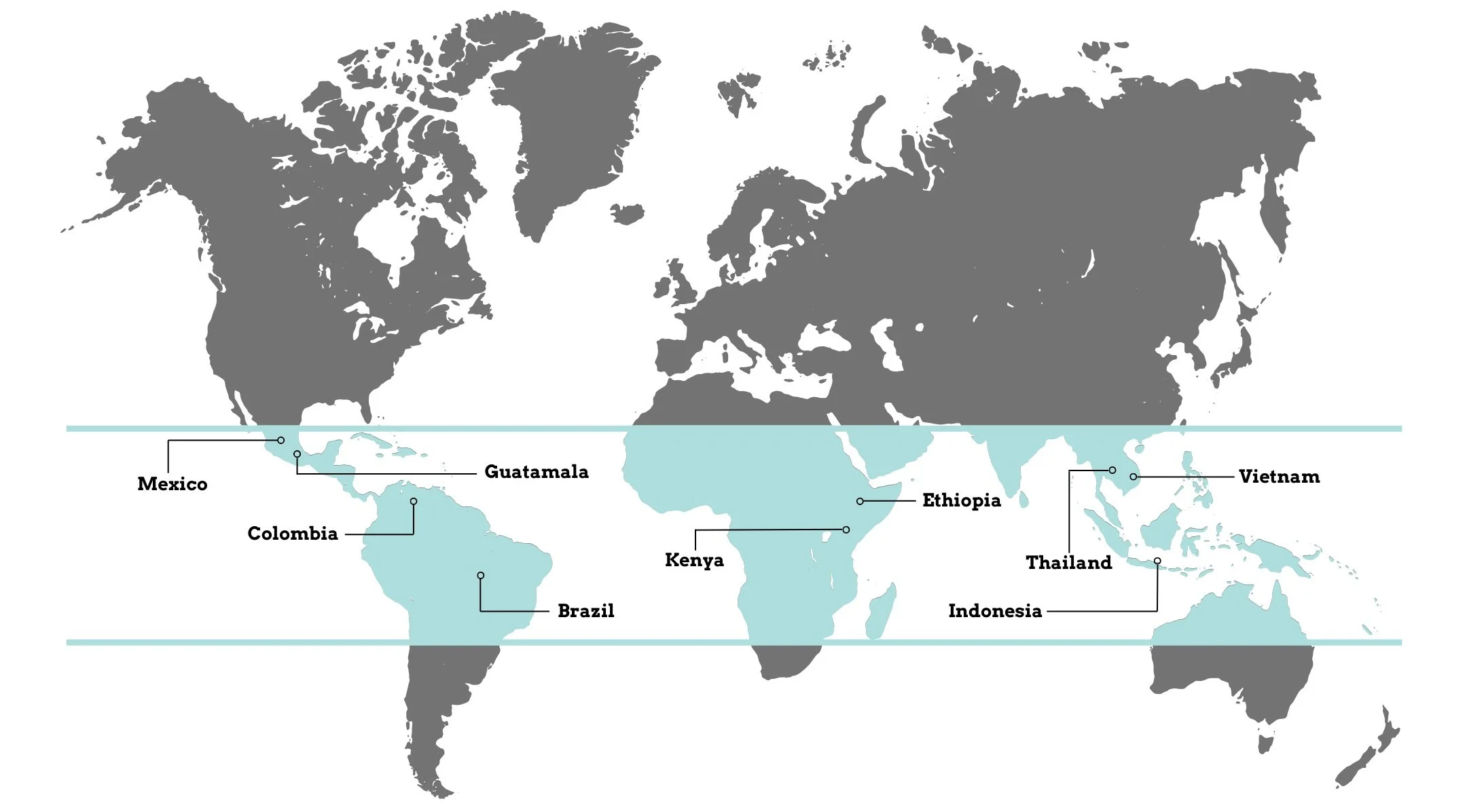Exploring the Coffee Bean Belt
Coffee, much like many other plants, requires a specific climate to thrive—particularly the warm and humid conditions of the tropics. This ideal coffee-growing region, known as the "coffee bean belt," spans between 25 degrees north and 30 degrees south of the equator. The belt encompasses three major coffee-producing regions: Central and South America, Africa, and Southeast Asia.
Each region within the coffee bean belt offers unique growing conditions that shape the diverse flavors and characteristics of coffee. Factors such as soil composition, climate, altitude, and bean variety all contribute to the distinct profiles of coffee from these areas. This results in a rich tapestry of flavors, from bright and fruity to earthy and robust.
Let’s delve into the unique flavor profiles and characteristics of each region and uncover what makes their coffee beans so distinctive and cherished by coffee enthusiasts around the world.
Central and South America
When searching for the perfect place to grow coffee, it doesn’t get better than this region. High altitudes and nutrient-rich volcanic soil play a part, but what truly makes their coffee universally loved is the climate. Predictable microclimates produce harmonious and balanced flavors, avoiding extremes of acidity or darkness.
Most coffee beans from this region come from Guatemala, Colombia, and Brazil. While Colombian coffee is renowned for its rich flavor and aroma, Brazil holds the distinction of being the world's largest coffee producer, a title it has proudly maintained for the past 150 years.
Central and South American coffees are known for their flavor profiles of chocolate, nuts, and caramel. Central American coffees are typically harmonious, mild, and bright, offering a clean and crisp taste. In contrast, South American varieties, due to their slightly lower altitudes, often feature a creamier texture with distinct chocolate undertones, making them a popular choice for coffee lovers seeking a richer cup.
Many of our blends are sourced from this region, providing a mid-bodied flavor profile that is widely appreciated. For instance, our house blend, Ruca, combines beans from Honduras and Guatemala, boasting flavors of milk chocolate, vanilla, and apple. If you're in search of something unique, try our single-origin Cordillera De Fuego from Costa Rica, which offers a delightful flavor profile with notes of churros, baked apple pie, and dried cherries.
Other beans we offer from Central and South America include:
Finca Angamaza: Loja, Ecuador
Feliciano Adame: Guerrero, Mexico
Finca Cerro Negro: Chalatenango, El Salvador
Amorat Espresso Blend: Honduras, Costa Rica, Colombia
Danger Zone: Honduras and Guatemala
Decaf: Colombia
Africa
African coffees are celebrated for their vibrant flavor profiles, often characterized by fruity, floral, and sweet notes. The higher altitudes in this region contribute to the beans' higher acidity, resulting in lighter-tasting notes. Many of these coffees come from Kenya, especially the Mount Kenya region, where the beans are renowned for their wine-like flavors. The combination of high altitudes, fertile soil, and ideal climate conditions contribute to the exceptional quality and abundant yield of Kenyan coffee.
Ethiopia, accounting for 3% of the world's coffee market, holds a special place in the hearts of coffee lovers as it is considered the birthplace of coffee. According to legend, coffee was discovered by an Ethiopian goat herder named Kaldi in the 9th century. Kaldi noticed his goats becoming unusually energetic after eating the red cherries from a certain tree. Intrigued, he tried the cherries himself, leading to the discovery of coffee.
Many of our single-origin coffees have come from this region over the years. Currently, our Chelbesa Washing Station and Tariku Kare beans, both from Ethiopia, showcase the unique fruity flavors that are characteristic of this area. These selections offer a taste of the rich coffee heritage and vibrant profiles that African coffees are known for.
Southeast Asia
Southeast Asian coffees are known for their distinctive and robust flavor profiles, often leaning towards earthy, herbal, and dark chocolate notes. This region, including countries like Vietnam, Indonesia, and Thailand, benefits from rich volcanic soils and diverse climates. The main distinction of beans from this area is their low acidity. Due to the lower average altitudes compared to other coffee-growing regions, fruity and lighter beans are less common here.
Vietnam, one of the world's largest coffee producers, is renowned for its strong, bold coffee with deep chocolate and earthy undertones. Thailand’s coffee farms, where Arabica coffee predominates, add a unique twist with subtle herbal and floral notes due to their geographical location nestled amongst the hillsides of Chiang Mai, Chiang Rai, and Mae Hong Son. Indonesian coffees, particularly from regions like Sumatra and Java, are famous for their unique earthy and herbal flavors, often featuring a full-bodied and syrupy texture. Java, being one of the oldest coffee-producing regions in Asia, has even become synonymous with coffee itself!
Understanding the coffee bean belt allows us to appreciate the diverse flavors and characteristics of coffee truly. Each region contributes unique qualities to the rich variety of coffee available today. Whether you prefer the bright, fruity notes of African beans or the earthy, robust flavors of Southeast Asian beans, exploring these regions can enhance your coffee experience and guide your choices when buying beans at the store. Next time you enjoy a cup, take a moment to consider the journey of the beans and the unique environment that shaped their flavor.
Hannah Pearson
Meet Hannah, a Pacific Northwest native with a Masters in Marketing. When she’s not crafting coffee behind the counter in Highwood, you’ll find her immersed in a good book, writing, or hitting the pavement for a good run. Whether it’s sipping coffee or chasing the next mile, she’s all about that perfect balance.



